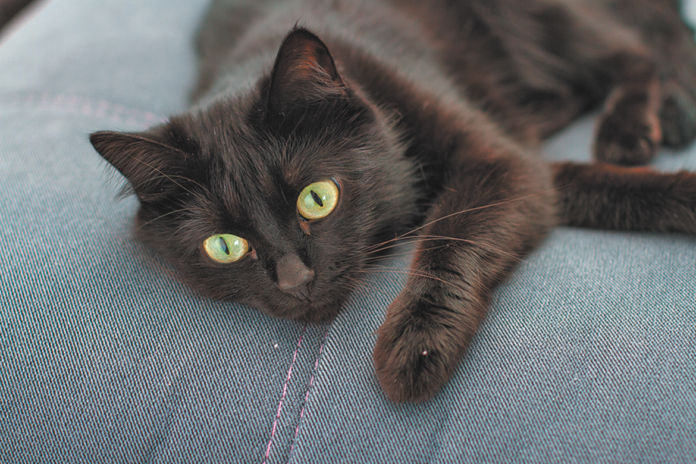Is there a fair amount of discharge coming from your cat’s eyes? A lot of crusty gunk in the corners? Are his eyes watering frequently? Make sure the veterinarian has a look at them. There are also a number of other tip-offs that something is wrong. Here’s how to check.
Home Eye Exam
Sometimes a cat will alert you to an eye problem with his body language. He may often be squinting or pawing at one or both of his eyes. That should most definitely prompt a home eye exam, but you should be checking your cat’s eyes once in a while even without those signs.
Start by making sure he’s in a brightly lit area, and look directly into them. (This may have to go somewhat fast. You don’t want your pet perceiving your direct gaze as a threat.)
The eyes should look clean and bright, with no discoloration in the whites. And the pupils should be the same size and color. After you’ve given the eyes the once-over, roll down your cat’s eyelid in each eye — gently, with your thumb — and note the color of the lid’s inner lining (the conjunctiva). If it’s pink, good. If it’s red or extremely white, something may very well be wrong.
If you see any crusty discharge, wipe it away with a damp cotton ball; warm tap water is helpful. Wipe from the corner of the eye only, and use fresh cotton for each eye. Cut any long hairs that could be obstructing his vision or poking into his eye. Do not use an eye wash unless one has been prescribed by your vet.
In addition to change in color or watery or crusty discharge, the following signs should prompt a call to the doctor’s office: tear-stained fur, closed or swollen eyes, or cloudy eyes. Here’s what the different signs may indicate.
Discharge. A little discharge, perhaps in the morning, may be nothing to worry about, especially if it’s clear. But more persistent discharge, including discharge that’s yellowish, could indicate an ocular or respiratory infection. It could also indicate an ulcer (open sore) in the cornea, which is the transparent front part of the eye. Another possibility is conjunctivitis — a type of ocular inflammation. Conjunctivitis can also result in eyes that are red and swollen.
Watery eyes. Your cat may have allergies to something in the environment or blocked tear ducts. Reddish discoloration of the fur around your cat’s eyes may also indicate blocked tear ducts. The fur literally becomes stained with tears that don’t properly make their way through the ducts.
Red eyelid linings. If the eyelid edge is red, it may mean your cat has blepharitis — inflammation of the eyelid. The eyelid may become swollen and itchy as well, and your cat might blink spasmodically (blepharospasm) and scratch or rub the spot.
Crusty discharge. “Morning eyes” are no big deal. But lots of crusty gunk that you need to wipe away several times a day could be a sign of an inflammation or infection.
Cloudy eyes. Eyes that are cloudy can be an indication of glaucoma — increased pressure inside the eye that can cause blindness if not treated early. Cloudy eyes can also be a sign of keratitis, an inflammatory disease of the cornea.
Change in eye color. An eye color change may signal a condition called uveitis, which involves the iris and may lead to serious consequences if ignored. Uveitis is usually painful; squinting is common. When the pain is severe, a cat may become quieter and less prone to play or behave normally.
A color change can also be due to melanoma of the iris, a cancer that unfortunately is all too common in cats. The iris of one eye becomes darker due to a tumor inside the eye. The affected eye generally has dark brown/black patches that can vary in number and size. The condition is not initially painful; the color change is usually the reason for examination. It is extremely important to see a veterinary ophthalmologist as soon as it is detected.
Visible third eyelid. All cats have a third eyelid. It’s generally hidden in the corner of the eye but sweeps across when a cat blinks, sort of like a windshield wiper, in order to clear away debris. However, if it’s constantly visible (even when you are not directly observing your cat), it could indicate a host of problems — anything from a wound to a virus to conjunctivitis or other types of ocular inflammation.
The good news is that many eye problems in cats can be treated with drops or other medicine if caught soon enough. In some cases a surgical procedure can fix the issue. So if something seems wrong with your cat’s eye (including bulging), don’t wait to make a veterinary appointment. Few eye issues can resolve on their own. Most only get worse without treatment.




